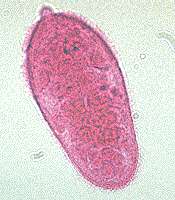Several orders of Cestoda with aquatic life cycles produce a coracidium which hatches from the egg and has an external cilciated coat (C) that enables it to swim and bring the oncosphere (O) into location where they might be eaten by a suitable intermediate host.

Most Digenea with aquatic life cycles produce a miracidium that hatches from the egg and swims in search of a molluscan host. Locomotion is provided by numerous ciliated plates covering the body surface.

Some miracidia, such as those of Stichorchis, already contain a well-developed sporocyst within.

"Larva" is the term given to the early stages of many organisms that undergo a series of molts before reaching maturity. Nematodes produce 4 laval stages, some of which are free-living and capable of short-distance dispersal.

Digenea with aquatic life cycles usually produce free-swimming cercariae. The tail (T) provides locomotion, while the soma (S), or body, is the part that will develop into the adult worm.

Active dispersal by adult stages does not occur for endoparasites; they use the host to transport them. Many ectoparasites, such as fleas, leave the host frequently. They can disperse for short distances, but the host is the main agent of dispersal.
